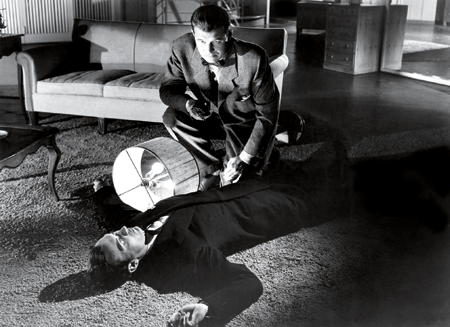
1945

EVERETT
Mildred Pierce
DIR. MICHAEL CURTIZ

EVERETT
Steely, sensational Joan Crawford as the redoubtable title character in Mildred Pierce—“one of the few noirs about female ambition, motherhood, and desire,” noir novelist Megan Abbott, author of You Will Know Me, tells LIFE.
How do you turn a tearjerker into noir? “Start with a murder, build in complicated flashbacks, and make the striving, suffering heroine a patsy for her second husband, her spoiled daughter, and a real estate man on the make,” says noir expert David Bordwell. “Then drench it all in chiaroscuro lighting, and add Joan Crawford’s burning eyes and slash-mouth. The result: Mildred Pierce.”
A loose adaptation of the 1941 James M. Cain novel, the film follows the titular character, a middle-class housewife and single mother (Joan Crawford) as she struggles to support her entitled elder daughter in Depression-era California. After she reunites with her freeloading ex-lover, “she’s expected to take a backseat again,” screenwriter and director David Koepp tells LIFE, “as was the case with so many independent American women when the Johnnys came marching home.”
The novel’s psychological, female-centric approach was atypical for Cain, who was mostly known for the hard-boiled works that spawned such film noir classics as Double Indemnity and The Postman Always Rings Twice. But in noir, “motherhood is never entirely natural, and female ambition—like all ambition in noir—comes at a heavy price,” novelist Megan Abbott tells LIFE. “Foremost, maternal sacrifice is not an honorable duty but, in some ways, a perversion.” Perhaps as a result of this dynamic, it proved hard to find an actress who wanted to play the middle-aged mom. “I didn’t like the story,” said actress Ann Sheridan after reading the script. “Mildred was too tough, and the kid was an absolute horror.”
When Sheridan, Bette Davis, and Rosalind Russell passed on the role, the 40-something Crawford got the part. It was a risky, if inspired, choice. Only six years earlier, LIFE had called Crawford “the first queen of the movies,” but after a string of underwhelming films she had been labeled “box office poison.” Even director Michael Curtiz was opposed to her—in part because he didn’t like the shoulder pads that had helped define her clotheshorse period at MGM.
But the film became Crawford’s comeback, her performance winning a Best Actress Oscar that surprised nearly everyone—not least the actress. “People in Hollywood don’t like me,” she had said, “and they’ve never regarded me as a good actress.” Not surprising, the film reinvigorated Crawford’s career, and the role became as much a part of her enduring image as the shopgirl-on-the-make parts that had first defined her.
After the film’s success, Crawford thanked Curtiz with a gift: a pair of custom-made shoulder pads.

EVERETT
A beach-house shooting kicks off Mildred Pierce’s twisty, shifty web of confusion, codependency, and lies.

EVERETT
Mildred confronts her devious daughter in the arms of her own paramour in the movie that defined motherly masochism.

PHOTOFEST
Reportedly, Crawford faked being sick on Oscar night because she was certain she would lose to the odds-on favorite, Ingrid Bergman in The Bells of St. Mary’s. When Crawford won, the coveted statuette was delivered by director Michael Curtiz to her in bed, where she just happened to be in full makeup—an imaginary invalid who was, in fact, more than ready for her close-up.